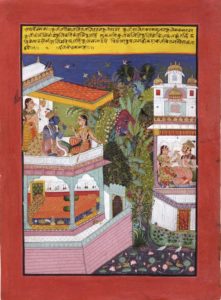Anytime the topic of Bombay’s weather is brought up, the sweaty summers and the thundering monsoon are always mentioned. You may even hear the occasional joke or two on how people in the city begin to shiver in the 20-degree. However, what most people do not tell you about is how the city looks during springtime. Bougainvillaea flowers flowing down the balconies, tree-leaves turned a dark shade of red, scattered all over the sidewalks and a mild evening-time breeze which comes like the ghost of winters past: these are the defining features of Bombay in early to mid-March.
https://www.instagram.com/p/BobmqVslX17/
According to the Hindu traditional calendar, the months of mid-March to mid-April are the Chaitra month. The month, in folklore and ancient Indian texts, is characterized by heavy romanticism and devotion. The month is described as one having beautiful moonlit evenings, the sounds of chirping koels, light winds which carry the sweet scent of the meadows on starlit nights which is the perfect setting for those in love. This is how Bombay feels like during the last days of its short-lived spring.
When one looks at pieces of art around the Chaitra month, images of Krishna with Radha often appear. However, apart from these paintings depicting Krishna, the month is also celebrated by the singing of Chaiti songs.

The Disappearing Music of Chaiti
Chaiti is a form of semi-classical Hindustani music. The songs usually focus on the elements of love and devotion – sometimes between two lovers and sometimes the relationship between the devotee and God. Another major element of these songs is that they are almost-always sung with the words ‘ho rama’ appearing multiple times. This addition is a tribute to Ram, the Indian God who was also born in this month – which is why it is one of the holiest months for the devotees.
Folk music can address a variety of themes and issues. Sometimes it can take a dark and grave tone where women left alone on the fields call trains as a step-wife. The Chaiti music, on the other hand, is all about happier times!
बाजत आनंद बधैया हो रामा, ऐलै चैत का महीनवा हो रामा
The most popular Chaiti song of all times was perhaps sung by Girija Devi, a Hindustani Classical singer known for her Thumri music. The song talks about a woman dressed up in colourful clothes, waiting for her beloved to return home.
चैत मास चुनरी रंगइबे हो रामा, पिया घर अइहैं।
Chaiti songs are popular in the socio-cultural region of Eastern Uttar Pradesh and parts of Bihar. However, these songs are found across various languages but largely follow the same tune and similar lyrics. In the past, there used to be yearly celebrations of ‘Chaiti Utsav’ where Chaiti singers from the region would gather and perform these songs. However, this is a tradition which is rapidly disappearing – Chaiti folk music festivals are limited to villages and rural areas, even from where they are disappearing.
In the past, some of India’s most celebrated names such as Girija Devi and Ustad Bismillah Khan have played Chaiti from time to time. These songs are mostly about love and devotion. Some lyrics describe the springtime Chaitra month as well as the romanticism around it in great detail.
कुसुमी लोढ़न हम जाएब हो रामा राजा केर बगिया,
मोर चुनरिया सैंयाँ तोर पगड़िया एकहि रंग रँगायब हो रामा।
The lines above describe how a woman goes to pick up flowers in a meadow and wants the colours of the flower on her dress and on the headgear of her lover, painting both of them in the springtime colours. While these songs are mostly about the celebration of spring or about lovers enjoying the weather, some Chaiti songs are about simpler things – such as the simple joy of sleeping in this pre-summer weather and when the person is woken up, he sings:
सुतला में काहेला जगैलऽ हो रामा
रस के सपनमा में हलइ अँखियाँ डूबल, अंग ही अंग अलसाए हो रामा
At a time when folk art is disappearing rapidly, some forms of folk art such as the Chaiti music continue to be relevant from time to time – especially during the seasonal celebrations of the Chaitra month. However, similar to how the song celebrates the final days of Spring, are we already in the last days of Chaiti music?